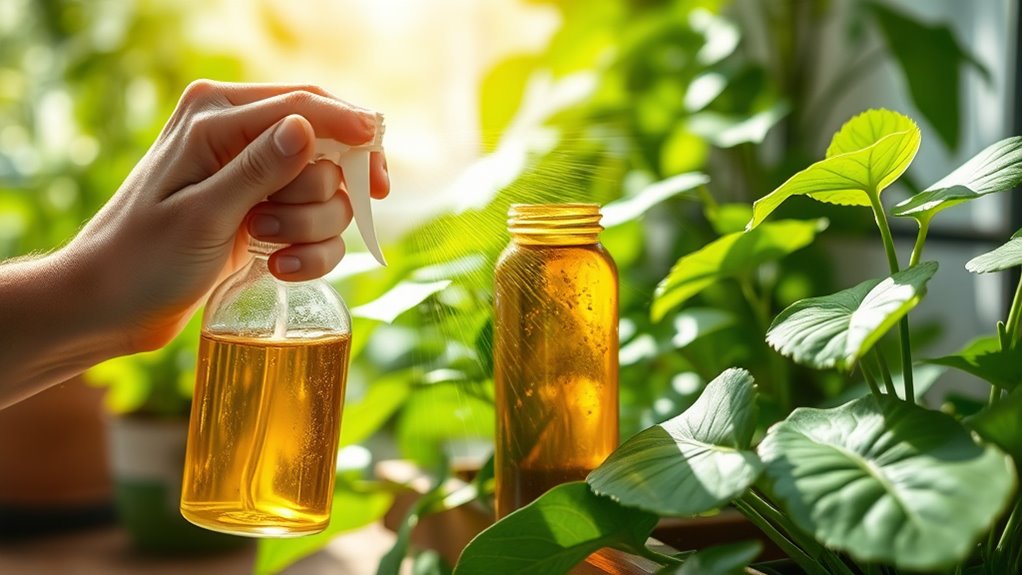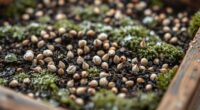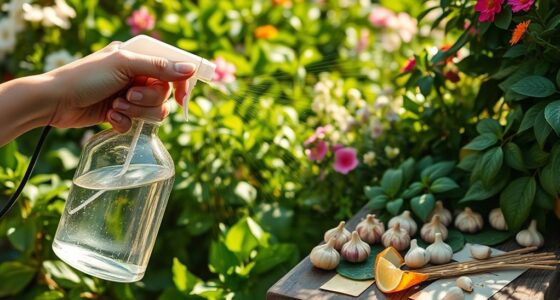To use neem oil safely on your plants, follow the instructions on the label carefully. Dilute it with water and add a few drops of liquid soap, then spray on both the tops and undersides of leaves, preferably in early morning or late evening. Apply every 7 to 14 days for best results. Avoid applying before rain or during high heat to prevent damage. Continue exploring these tips to maximize your garden’s health with neem oil.
Key Takeaways
- Dilute neem oil properly with water and add liquid soap before applying to ensure safe and effective coverage.
- Apply neem oil in early morning or late evening to prevent leaf burn and improve absorption.
- Target affected plants directly, covering both tops and undersides of leaves for best pest control results.
- Avoid application before rain or during high heat to prevent wash-off and plant damage.
- Use regular applications every 7 to 14 days to maintain pest control while supporting eco-friendly gardening.

Have you ever wondered how a single natural oil can transform your garden and health routines? Neem oil is a powerful tool that can do just that, especially if you’re committed to organic pest control and sustainable gardening. This versatile oil, derived from neem tree seeds, offers a safe and eco-friendly alternative to synthetic pesticides. When used properly, it can help you manage pests effectively while protecting beneficial insects and the environment.
Discover how neem oil can naturally transform your garden and health routines sustainably.
To start, it’s essential to understand how neem oil works. It contains compounds like azadirachtin that disrupt the life cycle of pests, preventing them from feeding and reproducing. Unlike chemical pesticides, neem oil doesn’t harm pollinators or other helpful insects when applied correctly. This makes it a favorite among gardeners seeking organic pest control solutions. It’s also biodegradable, so it won’t linger in the soil or water, aligning perfectly with sustainable gardening principles.
When you’re ready to use neem oil, always follow the instructions on the product label. Typically, you’ll dilute the oil with water and a small amount of liquid soap to help it stick to your plants’ surfaces. This mixture acts as a barrier against pests like aphids, whiteflies, and spider mites. The best time to apply neem oil is in the early morning or late evening, when temperatures are cooler and the sun isn’t at its peak. This reduces the risk of leaf burn and ensures better absorption. Regular applications, every 7 to 14 days, can keep pest populations under control without overdoing it.
You’ll want to target affected plants directly, making sure to cover both the tops and undersides of leaves where pests often hide. Applying neem oil in a gentle spray ensures you don’t damage the plants’ delicate tissues. Keep an eye out for weather conditions; avoid applying neem oil before rain or when the forecast predicts high heat, as excessive moisture can wash away the oil or cause leaf damage. Proper timing and application help you get the most benefit while maintaining an eco-friendly approach.
Using neem oil as part of your gardening routine not only safeguards your plants from pests but also aligns with your goal of sustainable gardening. It’s a natural, biodegradable solution that supports a healthy, balanced ecosystem in your garden. Over time, you’ll notice fewer pest issues and healthier plants, all while reducing your reliance on synthetic chemicals. With consistent use, neem oil becomes an invaluable resource that promotes organic pest control and helps you cultivate a thriving, eco-conscious garden.
Frequently Asked Questions
Can Neem Oil Be Used on Edible Plants Safely?
You can use neem oil on edible plants safely if you follow proper guidelines. It’s important to consider neem oil residues, which can remain on plants after application. To ensure edibles are safe, apply neem oil during the evening or early morning and wait at least 24 hours before harvesting. This helps maintain edible plant safety, reducing any potential risks from neem oil residues while keeping pests at bay.
How Often Should I Apply Neem Oil for Pest Control?
Think of your pest management schedule like a well-choreographed dance. You should apply neem oil every 7 to 14 days, depending on pest severity and plant response. The application frequency guarantees pests don’t become resistant, like the relentless tide of an ocean. Monitor your plants closely, adjusting the schedule as needed to keep pests at bay while safeguarding your greenery. Consistency is key to effective pest control.
Is Neem Oil Safe for Beneficial Insects Like Bees?
You wonder if neem oil is safe for beneficial insects like bees. While neem oil has low toxicity, it can still impact beneficial insects if applied during flowering or when bees are active. To protect them, apply neem oil early in the morning or late in the evening when bees are less active. Always follow label instructions carefully to minimize beneficial insect impact and reduce neem oil toxicity to your pollinators.
Can Neem Oil Cause Plant Damage or Leaf Burn?
Imagine your plants screaming for help—that’s what plant damage or leaf burn from neem oil can feel like if you ignore plant sensitivity and application timing. Neem oil is powerful, but if you spray during intense sunlight or on sensitive plants, it can scorch leaves or cause stress. To avoid this, always check plant sensitivity first and apply neem oil early in the morning or late evening when the sun’s less harsh.
Are There Any Plants That Should Not Be Treated With Neem Oil?
Some plants are sensitive species and shouldn’t be treated with neem oil due to potential toxic risks. Avoid applying neem oil to plants like azaleas, dogwood, or redbud, as they may react negatively. Always test a small area first and follow recommended dilution rates. If you notice any damage or unusual symptoms, stop treatment immediately to prevent harm. Knowing your plant’s sensitivity helps keep it healthy and safe.
Conclusion
Now that you know how to use neem oil safely, remember it’s a gentle guardian for your plants, not a magic wand. By following instructions, you nurture a healthy balance between pest control and nature’s harmony. Think of neem oil as a wise friend—trust it, but respect its power. When used responsibly, it becomes your secret weapon in cultivating vibrant, thriving gardens—proof that harmony with nature is the true path to lush, resilient plants.









